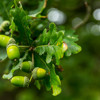A £382 billion asset – why UK trees need better protection and urgent investment

The UK's leading woodland conservation charity
New Woodland Natural Capital Accounts for the UK have been published by the Office for National Statistics.
The ONS has calculated an economic value for the UK’s trees and woods – £382 billion. This includes estimates for trees’ benefits to public health, cooling our cities, flood prevention, storing carbon and much else besides.
Totting up the annual benefits the ONS calculated for 2022 reveals some impressive numbers.
- Greenhouse gases – UK woodlands sequestered 19.6 million tonnes of greenhouse gases, valued at £5.1 billion (based on the 2021 figure).
- Health and recreation – annual health benefits from recreation in woodland were estimated at £1.1 billion.
- Air quality – UK woodlands removed over 316,000 tonnes of air pollutants worth an estimated £1.8 billion in avoided negative health impacts.
- Flood regulating – the annual value of trees in reducing flooding risk in the UK was estimated at £911 million.
- Urban heat regulating – the annual value of city trees in providing shade was estimated at £753 million.
Putting a value on something priceless is fraught with difficulty and potentially controversial – what value is a country without trees? But the ONS research highlights something which is incontrovertible.
Trees and woods improve our lives enormously and in many different ways. Some benefits such as contribution to sense of place are beyond calculation and do not feature in the ONS statistics.
The country has an asset worth hundreds of billions of pounds. We should be doing more to protect it and invest in it. Here are some examples of how we can do this.
We should create new woods in places where they will benefit the health and wellbeing of people and nature the most. Our Tree Equity work has begun to set out how we should do this.
We need to do more to look after the trees we have. That means better legal protection for our oldest and most important trees – defending them from development pressures.
We must restore more of our native woods to good ecological condition. That includes investing more in the skills needed to look after trees and woods and help ensure they stay healthy long into the future.
We should be growing more of the trees we plant domestically, so we end the reliance on imports and reduce the threat of new tree diseases arriving.
Actions like these are an investment in the future. They are essential to maintaining our trees and woods as a vital national asset.
Notes to editors
About the Woodland Trust
The Woodland Trust was established in 1972 and is now the UK’s largest woodland conservation charity, with more than 500,000 members and supporters.
With a vision of a world where woods and trees thrive for people and nature, today the Trust owns and cares for more than 1,000 woodland sites, covering around 33,000 hectares.
The Woodland Trust has three key aims:
- protecting the UK’s rare, unique and irreplaceable ancient woodland
- restoring damaged ancient woodland, nurturing precious pieces of our natural heritage back to life
- establishing new native trees and woods to create healthy, resilient landscapes for people and wildlife.
Access to all Woodland Trust woods is free so everyone can experience the physical and mental benefits of trees.

